So as part of the process of designing a human, the designer fused two ape chromosomes together. This would presumably be simpler than creating a human chromosome 2 the way the other chromosomes were made.
The difficulty with this idea is that there is no obvious advantage to having 46 chromosomes instead of 48. What matters is our DNA, not how it happens to be packaged.
It is possible that there was some advantage to fusing the chromosomes together. For example, maybe a new gene was created at the fusion point. Or maybe genes that were shut off before were now turned on in the new fused chromosomes.
There isn't any evidence of these kinds of things. And even if there were, a designer who can easily put in the 60 million or so differences between humans and chimpanzees should be able to accomplish whatever results a chromosome fusion gives more elegantly than sticking two ape chromosomes together.
Also, when you look at the fusion point, you can see that the DNA isn't exactly what you would expect if a fusion happened in the last 10,000 or even 100,000 years. The results look more like an event that happened millions of years ago.
The ends of a chromosome have a defined sequence of DNA repeats called a telomere. The DNA at the fusion point looks very similar to a string of telomeres (as we would expect from a fusion) but it isn't perfect. This is just what you would expect if the fusion happened millions of years ago. Because our DNA gets changed a little all of the time.
The environment or even our own cells can cause the wrong letter to end up in our DNA. Our cells are pretty good at fixing these mistakes but they don't catch them all. What this means is that our DNA builds up mutations over time.
When an unfixed change happens in a sperm or egg, then it is passed down to the next generation. If the changes that aren't fixed happen somewhere important, then they are selected for or against. But if they're neutral, then they just build up over time. Scientists can even use these sorts of errors to predict how long ago something happened. Or to trace human migration patterns.
These DNA changes at the fusion point do not fit with ID if they don't serve a purpose. Otherwise, why put them there? It will be interesting to see the results of experiments that might show if these sequences matter or not.
 Dr. Barry Starr is a Geneticist-in-Residence at The Tech Museum of Innovation in San Jose, CA.
Dr. Barry Starr is a Geneticist-in-Residence at The Tech Museum of Innovation in San Jose, CA.
37.332 -121.903

